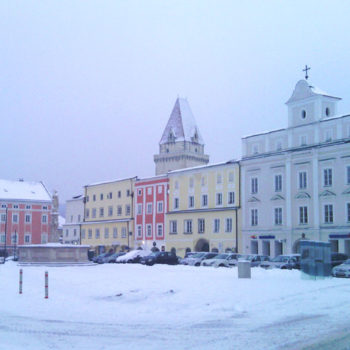The charm of Freistadt in northern Austria mainly comes from the well-preserved historic town centre, that still is surrounded by the original fortification walls. Furthermore, Freistadt also offers visitors great cultural, architectural and culinary delights.
Its historic centre (Altstadt) has by no means lapsed into a tourist trap but still functions as a place where people live. Furthermore, you find lots of shops, restaurants, patisseries and other businesses to keep you busy for a few days. Although I have been here numerous times and know the town well, I never get tired of strolling around this historic small town.
Towers, gates and the moat
I recommend starting your exploration by walking around the wall that encircles Freistadt. Get to know the seven towers, two main gates and the moat around the historic town centre. The moat has been drained and now consists of a mix of private gardens, leisure grounds and a park. Enter the old town through one of the six different openings in the wall and head for the central square, which is a good starting point for exploring Freistadt. There are many hidden treasures to be discovered on a stroll through the old town such as numerous arcaded courtyards and passageways. Moreover, as in most Austrian cities and towns, the main square (Hauptplatz / Marktplatz) is in the centre of the old town. Here, you will find banks, shops and eateries.
Lively market town
On the main square and some of the side streets, there are often organized markets and other activities. From May to October, but also on individual days in autumn and winter, at uneven intervals, they close most of the streets to traffic. Streets and alleys are lined with stalls of all kinds, and the crows liven up the town. Good food and drink are essential cultural ingredients for Austrians, and you rarely have to venture far to savour local delicacies. The market days are a highlight of the economic and gastronomic of the market days.
<< Click on the images to enlarge >>
Freistadt Castle
At the south end of the square, you can see the town’s main church (Stadtpfarrkirche) with its 67-meter-high church tower. In the northwest corner of the old town, the castle has found its strategic location. In keeping with the fact that the castle always has been the centre of power, it today houses the district government – and a museum. Moreover, tourists have access to parts of the castle through the museum. The view from the Keep (Bergfried) is fabulous. You get a nice view of the old town, the new town districts and surrounding hills.
163 preserved houses
It isn’t easy to pinpoint extraordinary sights in Freistadt’s historic centre, as there are 163 listed buildings within the town walls. Two fires in 1507 and 1516 destroyed most of the buildings in Freistadt. Nonetheless, the town was rebuilt, and over the centuries, it got architecture in Gothic, Baroque and Renaissance styles. Right angles are hard to find in the streets with the oldest buildings. If there was a shortage of measuring tape or if they just sagged over time, I do not know, but it adds plenty to the town’s charm.
ADVERTISEMENT
Fortified border town
Freistadt was founded in 1220 and placed strategically along the trade routes between the Danube and Bohemia. The border with Bohemia was a turbulent area and the town had to be fortified. The fortification walls around the town and its different towers, were constructed between 1363 and 1393. Freistadt experienced its peak as an important trading centre and powerhouse from the 14th to the 16th centuries. When Bohemia and Moravia (in today’s Czech Republic) where merged into the Habsburg empire in 1627, the town’s importance as a border town and trading place dwindled.
Post iron curtain revival
After the fall of the iron curtain in the early 1990s, Freistadt awoke from centuries’ long slumber. It became an important shopping town, as the cross-border traffic between Austria and the Czech Republic exploded. Today, the town attracts numerous Czechs as well as tourists from all over Europe.













